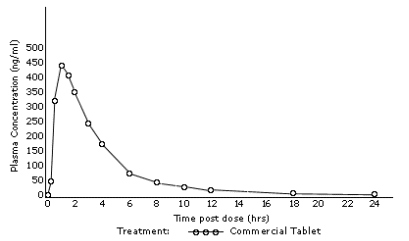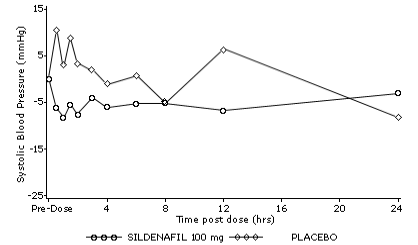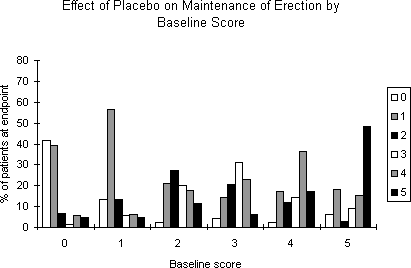(sildenafil citrate) Tablets
Description
Pharmacology
Indications and Usage
Contraindications
Warnings
Precautions
Drug Interactions
Adverse Reactions
Overdose
Dosage
Supplied
DESCRIPTION
VIAGRA®, an oral therapy for erectile dysfunction, is the citrate salt of sildenafil, a selective inhibitor of cyclic guanosine monophosphate (cGMP)-specific phosphodiesterase type 5 (PDE5).
Sildenafil citrate is designated chemically as 1-[[3-(6,7-dihydro-1-methyl-7-oxo-3-propyl-1Hpyrazolo[ 4,3-d]pyrimidin-5-yl)-4-ethoxyphenyl]sulfonyl]-4-methylpiperazine citrate and has the following structural formula:

Sildenafil citrate is a white to off-white crystalline powder with a solubility of 3.5 mg/mL in water and a molecular weight of 666.7. VIAGRA (sildenafil citrate) is formulated as blue, film-coated rounded-diamond-shaped tablets equivalent to 25 mg, 50 mg and 100 mg of sildenafil for oral administration. In addition to the active ingredient, sildenafil citrate, each tablet contains the following inactive ingredients: microcrystalline cellulose, anhydrous dibasic calcium phosphate, croscarmellose sodium, magnesium stearate, hypromellose, titanium dioxide, lactose, triacetin, and FD & C Blue #2 aluminum lake.
top
CLINICAL PHARMACOLOGY
Mechanism of Action
The physiologic mechanism of erection of the penis involves release of nitric oxide (NO) in the corpus cavernosum during sexual stimulation. NO then activates the enzyme guanylate cyclase, which results in increased levels of cyclic guanosine monophosphate (cGMP), producing smooth muscle relaxation in the corpus cavernosum and allowing inflow of blood. Sildenafil has no direct relaxant effect on isolated human corpus cavernosum, but enhances the effect of nitric oxide (NO) by inhibiting phosphodiesterase type 5 (PDE5), which is responsible for degradation of cGMP in the corpus cavernosum. When sexual stimulation causes local release of NO, inhibition of PDE5 by sildenafil causes increased levels of cGMP in the corpus cavernosum, resulting in smooth muscle relaxation and inflow of blood to the corpus cavernosum. Sildenafil at recommended doses has no effect in the absence of sexual stimulation.
Studies in vitro have shown that sildenafil is selective for PDE5. Its effect is more potent on PDE5 than on other known phosphodiesterases (10-fold for PDE6, >80-fold for PDE1, >700-fold for PDE2, PDE3, PDE4, PDE7, PDE8, PDE9, PDE10, and PDE11). The approximately 4,000-fold selectivity for PDE5 versus PDE3 is important because PDE3 is involved in control of cardiac contractility. Sildenafil is only about 10-fold as potent for PDE5 compared to PDE6, an enzyme found in the retina which is involved in the phototransduction pathway of the retina. This lower selectivity is thought to be the basis for abnormalities related to color vision observed with higher doses or plasma levels (see Pharmacodynamics).
In addition to human corpus cavernosum smooth muscle, PDE5 is also found in lower concentrations in other tissues including platelets, vascular and visceral smooth muscle, and skeletal muscle. The inhibition of PDE5 in these tissues by sildenafil may be the basis for the enhanced platelet antiaggregatory activity of nitric oxide observed in vitro, an inhibition of platelet thrombus formation in vivo and peripheral arterial-venous dilatation in vivo.
Pharmacokinetics and Metabolism
VIAGRA is rapidly absorbed after oral administration, with absolute bioavailability of about 40%. Its pharmacokinetics are dose-proportional over the recommended dose range. It is eliminated predominantly by hepatic metabolism (mainly cytochrome P450 3A4) and is converted to an active metabolite with properties similar to the parent, sildenafil. The concomitant use of potent cytochrome P450 3A4 inhibitors (e.g., erythromycin, ketoconazole, itraconazole) as well as the nonspecific CYP inhibitor, cimetidine, is associated with increased plasma levels of sildenafil (see DOSAGE AND ADMINISTRATION). Both sildenafil and the metabolite have terminal half lives of about 4 hours.
Mean sildenafil plasma concentrations measured after the administration of a single oral dose of 100 mg to healthy male volunteers is depicted below:

Figure 1: Mean Sildenafil Plasma Concentrations in Healthy Male Volunteers.
Absorption and Distribution: VIAGRA is rapidly absorbed. Maximum observed plasma concentrations are reached within 30 to 120 minutes (median 60 minutes) of oral dosing in the fasted state. When VIAGRA is taken with a high fat meal, the rate of absorption is reduced, with a mean delay in Tmax of 60 minutes and a mean reduction in Cmax of 29%. The mean steady state volume of distribution (Vss) for sildenafil is 105 L, indicating distribution into the tissues. Sildenafil and its major circulating N-desmethyl metabolite are both approximately 96% bound to plasma proteins. Protein binding is independent of total drug concentrations.
Based upon measurements of sildenafil in semen of healthy volunteers 90 minutes after dosing, less than 0.001% of the administered dose may appear in the semen of patients.
Metabolism and Excretion: Sildenafil is cleared predominantly by the CYP3A4 (major route) and CYP2C9 (minor route) hepatic microsomal isoenzymes. The major circulating metabolite results from N-desmethylation of sildenafil, and is itself further metabolized. This metabolite has a PDE selectivity profile similar to sildenafil and an in vitro potency for PDE5 approximately 50% of the parent drug. Plasma concentrations of this metabolite are approximately 40% of those seen for sildenafil, so that the metabolite accounts for about 20% of sildenafil's pharmacologic effects.
After either oral or intravenous administration, sildenafil is excreted as metabolites predominantly in the feces (approximately 80% of administered oral dose) and to a lesser extent in the urine (approximately 13% of the administered oral dose). Similar values for pharmacokinetic parameters were seen in normal volunteers and in the patient population, using a population pharmacokinetic approach.
Pharmacokinetics in Special Populations
Geriatrics: Healthy elderly volunteers (65 years or over) had a reduced clearance of sildenafil, with free plasma concentrations approximately 40% greater than those seen in healthy younger volunteers (18-45 years).
Renal Insufficiency: In volunteers with mild (CLcr=50-80 mL/min) and moderate (CLcr=30-49 mL/min) renal impairment, the pharmacokinetics of a single oral dose of VIAGRA (50 mg) were not altered. In volunteers with severe (CLcr=<30 mL/min) renal impairment, sildenafil clearance was reduced, resulting in approximately doubling of AUC and Cmax compared to age-matched volunteers with no renal impairment.
Hepatic Insufficiency: In volunteers with hepatic cirrhosis (Child-Pugh A and B), sildenafil clearance was reduced, resulting in increases in AUC (84%) and Cmax (47%) compared to age-matched volunteers with no hepatic impairment.
Therefore, age >65, hepatic impairment and severe renal impairment are associated with increased plasma levels of sildenafil. A starting oral dose of 25 mg should be considered in those patients (see DOSAGE AND ADMINISTRATION).
Pharmacodynamics
Effects of VIAGRA on Erectile Response: In eight double-blind, placebo-controlled crossover studies of patients with either organic or psychogenic erectile dysfunction, sexual stimulation resulted in improved erections, as assessed by an objective measurement of hardness and duration of erections (RigiScan®), after VIAGRA administration compared with placebo. Most studies assessed the efficacy of VIAGRA approximately 60 minutes post dose. The erectile response, as assessed by RigiScan®, generally increased with increasing sildenafil dose and plasma concentration. The time course of effect was examined in one study, showing an effect for up to 4 hours but the response was diminished compared to 2 hours.
Effects of VIAGRA on Blood Pressure: Single oral doses of sildenafil (100 mg) administered to healthy volunteers produced decreases in supine blood pressure (mean maximum decrease in systolic/diastolic blood pressure of 8.4/5.5 mmHg). The decrease in blood pressure was most notable approximately 1-2 hours after dosing, and was not different than placebo at 8 hours. Similar effects on blood pressure were noted with 25 mg, 50 mg and 100 mg of VIAGRA, therefore the effects are not related to dose or plasma levels within this dosage range. Larger effects were recorded among patients receiving concomitant nitrates (see CONTRAINDICATIONS).

Figure 2: Mean Change from Baseline in Sitting Systolic Blood Pressure, Healthy Volunteers.
Effects of VIAGRA on Cardiac Parameters: Single oral doses of sildenafil up to 100 mg produced no clinically relevant changes in the ECGs of normal male volunteers.
Studies have produced relevant data on the effects of VIAGRA on cardiac output. In one small, open-label, uncontrolled, pilot study, eight patients with stable ischemic heart disease underwent Swan-Ganz catheterization. A total dose of 40 mg sildenafil was administered by four intravenous infusions.
The results from this pilot study are shown in Table 1; the mean resting systolic and diastolic blood pressures decreased by 7% and 10% compared to baseline in these patients. Mean resting values for right atrial pressure, pulmonary artery pressure, pulmonary artery occluded pressure and cardiac output decreased by 28%, 28%, 20% and 7% respectively. Even though this total dosage produced plasma sildenafil concentrations which were approximately 2 to 5 times higher than the mean maximum plasma concentrations following a single oral dose of 100 mg in healthy male volunteers, the hemodynamic response to exercise was preserved in these patients.
TABLE 1. HEMODYNAMIC DATA IN PATIENTS WITH STABLE ISCHEMIC HEART DISEASE AFTER IV ADMINISTRATION OF 40 MG SILDENAFIL
| Means ± SD | At rest | After 4 minutes of exercise |
| | n | Baseline
(B2) | n | Sildenafil
(D1) | n | Baseline | n | Sildenafil |
| PAOP (mmHg) | 8 | 8.1 ± 5.1 | 8 | 6.5 ± 4.3 | 8 | 36.0 ± 13.7 | 8 | 27.8 ± 15.3 |
| Mean PAP (mmHg) | 8 | 16.7 ± 4 | 8 | 12.1 ± 3.9 | 8 | 39.4 ± 12.9 | 8 | 31.7 ± 13.2 |
| Mean RAP (mmHg) | 7 | 5.7 ± 3.7 | 8 | 4.1 ± 3.7 | - | - | - | - |
| Systolic SAP (mmHg) | 8 | 150.4 ± 12.4 | 8 | 140.6 ± 16.5 | 8 | 199.5 ± 37.4 | 8 | 187.8 ± 30.0 |
| Diastolic SAP (mmHg) | 8 | 73.6 ± 7.8 | 8 | 65.9 ± 10 | 8 | 84.6 ± 9.7 | 8 | 79.5 ± 9.4 |
| Cardiac output (L/min) | 8 | 5.6 ± 0.9 | 8 | 5.2 ± 1.1 | 8 | 11.5 ± 2.4 | 8 | 10.2 ± 3.5 |
| Heart rate (bpm) | 8 | 67 ± 11.1 | 8 | 66.9 ± 12 | 8 | 101.9 ± 11.6 | 8 | 99.0 ± 20.4 |
In a double-blind study, 144 patients with erectile dysfunction and chronic stable angina limited by exercise, not receiving chronic oral nitrates, were randomized to a single dose of placebo or VIAGRA 100 mg 1 hour prior to exercise testing. The primary endpoint was time to limiting angina in the evaluable cohort. The mean times (adjusted for baseline) to onset of limiting angina were 423.6 and 403.7 seconds for sildenafil (N=70) and placebo, respectively. These results demonstrated that the effect of VIAGRA on the primary endpoint was statistically non-inferior to placebo.
Effects of VIAGRA on Vision: At single oral doses of 100 mg and 200 mg, transient dose-related impairment of color discrimination (blue/green) was detected using the Farnsworth-Munsell 100-hue test, with peak effects near the time of peak plasma levels. This finding is consistent with the inhibition of PDE6, which is involved in phototransduction in the retina. An evaluation of visual function at doses up to twice the maximum recommended dose revealed no effects of VIAGRA on visual acuity, intraocular pressure, or pupillometry.
Clinical Studies
In clinical studies, VIAGRA was assessed for its effect on the ability of men with erectile dysfunction (ED) to engage in sexual activity and in many cases specifically on the ability to achieve and maintain an erection sufficient for satisfactory sexual activity. VIAGRA was evaluated primarily at doses of 25 mg, 50 mg and 100 mg in 21 randomized, double-blind, placebo-controlled trials of up to 6 months in duration, using a variety of study designs (fixed dose, titration, parallel, crossover). VIAGRA was administered to more than 3,000 patients aged 19 to 87 years, with ED of various etiologies (organic, psychogenic, mixed) with a mean duration of 5 years. VIAGRA demonstrated statistically significant improvement compared to placebo in all 21 studies. The studies that established benefit demonstrated improvements in success rates for sexual intercourse compared with placebo.
The effectiveness of VIAGRA was evaluated in most studies using several assessment instruments. The primary measure in the principal studies was a sexual function questionnaire (the International Index of Erectile Function - IIEF) administered during a 4-week treatment-free run-in period, at baseline, at follow-up visits, and at the end of double-blind, placebo-controlled, at-home treatment. Two of the questions from the IIEF served as primary study endpoints; categorical responses were elicited to questions about (1) the ability to achieve erections sufficient for sexual intercourse and (2) the maintenance of erections after penetration. The patient addressed both questions at the final visit for the last 4 weeks of the study. The possible categorical responses to these questions were (0) no attempted intercourse, (1) never or almost never, (2) a few times, (3) sometimes, (4) most times, and (5) almost always or always. Also collected as part of the IIEF was information about other aspects of sexual function, including information on erectile function, orgasm, desire, satisfaction with intercourse, and overall sexual satisfaction. Sexual function data were also recorded by patients in a daily diary. In addition, patients were asked a global efficacy question and an optional partner questionnaire was administered.
The effect on one of the major end points, maintenance of erections after penetration, is shown in Figure 3, for the pooled results of 5 fixed-dose, dose-response studies of greater than one month duration, showing response according to baseline function. Results with all doses have been pooled, but scores showed greater improvement at the 50 and 100 mg doses than at 25 mg. The pattern of responses was similar for the other principal question, the ability to achieve an erection sufficient for intercourse. The titration studies, in which most patients received 100 mg, showed similar results. Figure 3 shows that regardless of the baseline levels of function, subsequent function in patients treated with VIAGRA was better than that seen in patients treated with placebo. At the same time, on-treatment function was better in treated patients who were less impaired at baseline.

Figure 3. Effect of VIAGRA and Placebo on
Maintenance of Erection by Baseline Score.
The frequency of patients reporting improvement of erections in response to a global question in four of the randomized, double-blind, parallel, placebo-controlled fixed dose studies (1797 patients) of 12 to 24 weeks duration is shown in Figure 4. These patients had erectile dysfunction at baseline that was characterized by median categorical scores of 2 (a few times) on principal IIEF questions. Erectile dysfunction was attributed to organic (58%; generally not characterized, but including diabetes and excluding spinal cord injury), psychogenic (17%), or mixed (24%) etiologies. Sixty-three percent, 74%, and 82% of the patients on 25 mg, 50 mg and 100 mg of VIAGRA, respectively, reported an improvement in their erections, compared to 24% on placebo. In the titration studies (n=644) (with most patients eventually receiving 100 mg), results were similar.

Figure 4. Percentage of Patients Reporting an Improvement in Erections.
The patients in studies had varying degrees of ED. One-third to one-half of the subjects in these studies reported successful intercourse at least once during a 4-week, treatment-free run-in period.
In many of the studies, of both fixed dose and titration designs, daily diaries were kept by patients. In these studies, involving about 1600 patients, analyses of patient diaries showed no effect of VIAGRA on rates of attempted intercourse (about 2 per week), but there was clear treatment-related improvement in sexual function: per patient weekly success rates averaged 1.3 on 50-100 mg of VIAGRA vs 0.4 on placebo; similarly, group mean success rates (total successes divided by total attempts) were about 66% on VIAGRA vs about 20% on placebo.
During 3 to 6 months of double-blind treatment or longer-term (1 year), open-label studies, few patients withdrew from active treatment for any reason, including lack of effectiveness. At the end of the long-term study, 88% of patients reported that VIAGRA improved their erections.
Men with untreated ED had relatively low baseline scores for all aspects of sexual function measured (again using a 5-point scale) in the IIEF. VIAGRA improved these aspects of sexual function: frequency, firmness and maintenance of erections; frequency of orgasm; frequency and level of desire; frequency, satisfaction and enjoyment of intercourse; and overall relationship satisfaction.
One randomized, double-blind, flexible-dose, placebo-controlled study included only patients with erectile dysfunction attributed to complications of diabetes mellitus (n=268). As in the other titration studies, patients were started on 50 mg and allowed to adjust the dose up to 100 mg or down to 25 mg of VIAGRA; all patients, however, were receiving 50 mg or 100 mg at the end of the study. There were highly statistically significant improvements on the two principal IIEF questions (frequency of successful penetration during sexual activity and maintenance of erections after penetration) on VIAGRA compared to placebo. On a global improvement question, 57% of VIAGRA patients reported improved erections versus 10% on placebo. Diary data indicated that on VIAGRA, 48% of intercourse attempts were successful versus 12% on placebo.
One randomized, double-blind, placebo-controlled, crossover, flexible-dose (up to 100 mg) study of patients with erectile dysfunction resulting from spinal cord injury (n=178) was conducted. The changes from baseline in scoring on the two end point questions (frequency of successful penetration during sexual activity and maintenance of erections after penetration) were highly statistically significantly in favor of VIAGRA. On a global improvement question, 83% of patients reported improved erections on VIAGRA versus 12% on placebo. Diary data indicated that on VIAGRA, 59% of attempts at sexual intercourse were successful compared to 13% on placebo.
Across all trials, VIAGRA improved the erections of 43% of radical prostatectomy patients compared to 15% on placebo.
Subgroup analyses of responses to a global improvement question in patients with psychogenic etiology in two fixed-dose studies (total n=179) and two titration studies (total n=149) showed 84% of VIAGRA patients reported improvement in erections compared with 26% of placebo. The changes from baseline in scoring on the two end point questions (frequency of successful penetration during sexual activity and maintenance of erections after penetration) were highly statistically significantly in favor of VIAGRA. Diary data in two of the studies (n=178) showed rates of successful intercourse per attempt of 70% for VIAGRA and 29% for placebo.
A review of population subgroups demonstrated efficacy regardless of baseline severity, etiology, race and age. VIAGRA was effective in a broad range of ED patients, including those with a history of coronary artery disease, hypertension, other cardiac disease, peripheral vascular disease, diabetes mellitus, depression, coronary artery bypass graft (CABG), radical prostatectomy, transurethral resection of the prostate (TURP) and spinal cord injury, and in patients taking antidepressants/antipsychotics and antihypertensives/diuretics.
Analysis of the safety database showed no apparent difference in the side effect profile in patients taking VIAGRA with and without antihypertensive medication. This analysis was performed retrospectively, and was not powered to detect any pre-specified difference in adverse reactions.
INDICATION AND USAGE
VIAGRA is indicated for the treatment of erectile dysfunction.
CONTRAINDICATIONS
Consistent with its known effects on the nitric oxide/cGMP pathway (see CLINICAL PHARMACOLOGY), VIAGRA was shown to potentiate the hypotensive effects of nitrates, and its administration to patients who are using organic nitrates, either regularly and/or intermittently, in any form is therefore contraindicated.
After patients have taken VIAGRA, it is unknown when nitrates, if necessary, can be safely administered. Based on the pharmacokinetic profile of a single 100 mg oral dose given to healthy normal volunteers, the plasma levels of sildenafil at 24 hours post dose are approximately 2 ng/mL (compared to peak plasma levels of approximately 440 ng/mL) (see CLINICAL PHARMACOLOGY: Pharmacokinetics and Metabolism). In the following patients: age >65, hepatic impairment (e.g., cirrhosis), severe renal impairment (e.g., creatinine clearance <30 mL/min), and concomitant use of potent cytochrome P450 3A4 inhibitors (erythromycin), plasma levels of sildenafil at 24 hours post dose have been found to be 3 to 8 times higher than those seen in healthy volunteers. Although plasma levels of sildenafil at 24 hours post dose are much lower than at peak concentration, it is unknown whether nitrates can be safely coadministered at this time point.
VIAGRA is contraindicated in patients with a known hypersensitivity to any component of the tablet.
WARNINGS
There is a potential for cardiac risk of sexual activity in patients with preexisting cardiovascular disease. Therefore, treatments for erectile dysfunction, including VIAGRA, should not be generally used in men for whom sexual activity is inadvisable because of their underlying cardiovascular status.
VIAGRA has systemic vasodilatory properties that resulted in transient decreases in supine blood pressure in healthy volunteers (mean maximum decrease of 8.4/5.5 mmHg), (see CLINICAL PHARMACOLOGY: Pharmacodynamics). While this normally would be expected to be of little consequence in most patients, prior to prescribing VIAGRA, physicians should carefully consider whether their patients with underlying cardiovascular disease could be affected adversely by such vasodilatory effects, especially in combination with sexual activity.
Patients with the following underlying conditions can be particularly sensitive to the actions of vasodilators including VIAGRA - those with left ventricular outflow obstruction (e.g. aortic stenosis, idiopathic hypertrophic subaortic stenosis) and those with severely impaired autonomic control of blood pressure.
There is no controlled clinical data on the safety or efficacy of VIAGRA in the following groups; if prescribed, this should be done with caution.
- Patients who have suffered a myocardial infarction, stroke, or life-threatening arrhythmia within the last 6 months;
- Patients with resting hypotension (BP 170/110);
- Patients with cardiac failure or coronary artery disease causing unstable angina;
- Patients with retinitis pigmentosa (a minority of these patients have genetic disorders of retinal phosphodiesterases).
Prolonged erection greater than 4 hours and priapism (painful erections greater than 6 hours in duration) have been reported infrequently since market approval of VIAGRA. In the event of an erection that persists longer than 4 hours, the patient should seek immediate medical assistance. If priapism is not treated immediately, penile tissue damage and permanent loss of potency could result.
The concomitant administration of the protease inhibitor ritonavir substantially increases serum concentrations of sildenafil (11-fold increase in AUC). If VIAGRA is prescribed to patients taking ritonavir, caution should be used. Data from subjects exposed to high systemic levels of sildenafil are limited. Visual disturbances occurred more commonly at higher levels of sildenafil exposure. Decreased blood pressure, syncope, and prolonged erection were reported in some healthy volunteers exposed to high doses of sildenafil (200-800 mg). To decrease the chance of adverse events in patients taking ritonavir, a decrease in sildenafil dosage is recommended (see Drug Interactions, ADVERSE REACTIONS and DOSAGE AND ADMINISTRATION).
PRECAUTIONS
General
The evaluation of erectile dysfunction should include a determination of potential underlying causes and the identification of appropriate treatment following a complete medical assessment.
Before prescribing VIAGRA, it is important to note the following:
Patients on multiple antihypertensive medications were included in the pivotal clinical trials for VIAGRA. In a separate drug interaction study, when amlodipine, 5 mg or 10 mg, and VIAGRA, 100 mg were orally administered concomitantly to hypertensive patients mean additional blood pressure reduction of 8 mmHg systolic and 7 mmHg diastolic were noted (see Drug Interactions).
When the alpha blocker doxazosin (4 mg) and VIAGRA (25 mg) were administered simultaneously to patients with benign prostatic hyperplasia (BPH), mean additional reductions of supine blood pressure of 7 mmHg systolic and 7 mmHg diastolic were observed. When higher doses of VIAGRA and doxazosin (4 mg) were administered simultaneously, there were infrequent reports of patients who experienced symptomatic postural hypotension within 1 to 4 hours of dosing. Simultaneous administration of VIAGRA to patients taking alpha-blocker therapy may lead to symptomatic hypotension in some patients. Therefore, VIAGRA doses above 25 mg should not be taken within 4 hours of taking an alpha-blocker
The safety of VIAGRA is unknown in patients with bleeding disorders and patients with active peptic ulceration.
VIAGRA should be used with caution in patients with anatomical deformation of the penis (such as angulation, cavernosal fibrosis or Peyronie's disease), or in patients who have conditions which may predispose them to priapism (such as sickle cell anemia, multiple myeloma, or leukemia).
The safety and efficacy of combinations of VIAGRA with other treatments for erectile dysfunction have not been studied. Therefore, the use of such combinations is not recommended.
In humans, VIAGRA has no effect on bleeding time when taken alone or with aspirin. In vitro studies with human platelets indicate that sildenafil potentiates the antiaggregatory effect of sodium nitroprusside (a nitric oxide donor). The combination of heparin and VIAGRA had an additive effect on bleeding time in the anesthetized rabbit, but this interaction has not been studied in humans.
Information for Patients
Physicians should discuss with patients the contraindication of VIAGRA with regular and/or intermittent use of organic nitrates.
Physicians should discuss with patients the potential cardiac risk of sexual activity in patients with preexisting cardiovascular risk factors. Patients who experience symptoms (e.g., angina pectoris, dizziness, nausea) upon initiation of sexual activity should be advised to refrain from further activity and should discuss the episode with their physician.
Physicians should advise patients to stop use of all PDE5 inhibitors, including VIAGRA, and seek medical attention in the event of a sudden loss of vision in one or both eyes. Such an event may be a sign of non-arteritic anterior ischemic optic neuropathy (NAION), a cause of decreased vision including permanent loss of vision, that has been reported rarely post-marketing in temporal association with the use of all PDE5 inhibitors. It is not possible to determine whether these events are related directly to the use of PDE5 inhibitors or to other factors. Physicians should also discuss with patients the increased risk of NAION in individuals who have already experienced NAION in one eye, including whether such individuals could be adversely affected by use of vasodilators, such as PDE5 inhibitors (see POSTMARKETING EXPERIENCE/Special Senses).
Physicians should warn patients that prolonged erections greater than 4 hours and priapism (painful erections greater than 6 hours in duration) have been reported infrequently since market approval of VIAGRA. In the event of an erection that persists longer than 4 hours, the patient should seek immediate medical assistance. If priapism is not treated immediately, penile tissue damage and permanent loss of potency may result.
Physicians should advise patients that simultaneous administration of VIAGRA doses above 25 mg and an alpha-blocker may lead to symptomatic hypotension in some patients. Therefore, VIAGRA doses above 25 mg should not be taken within four hours of taking an alpha-blocker.
The use of VIAGRA offers no protection against sexually transmitted diseases. Counseling of patients about the protective measures necessary to guard against sexually transmitted diseases, including the Human Immunodeficiency Virus (HIV), may be considered.
Drug Interactions
Effects of Other Drugs on VIAGRA
In vitro studies: Sildenafil metabolism is principally mediated by the cytochrome P450 (CYP) isoforms 3A4 (major route) and 2C9 (minor route). Therefore, inhibitors of these isoenzymes may reduce sildenafil clearance.
In vivo studies: Cimetidine (800 mg), a nonspecific CYP inhibitor, caused a 56% increase in plasma sildenafil concentrations when coadministered with VIAGRA (50 mg) to healthy volunteers.
When a single 100 mg dose of VIAGRA was administered with erythromycin, a specific CYP3A4 inhibitor, at steady state (500 mg bid for 5 days), there was a 182% increase in sildenafil systemic exposure (AUC). In addition, in a study performed in healthy male volunteers, coadministration of the HIV protease inhibitor saquinavir, also a CYP3A4 inhibitor, at steady state (1200 mg tid) with VIAGRA (100 mg single dose) resulted in a 140% increase in sildenafil Cmax and a 210% increase in sildenafil AUC. VIAGRA had no effect on saquinavir pharmacokinetics. Stronger CYP3A4 inhibitors such as ketoconazole or itraconazole would be expected to have still greater effects, and population data from patients in clinical trials did indicate a reduction in sildenafil clearance when it was coadministered with CYP3A4 inhibitors (such as ketoconazole, erythromycin, or cimetidine) (see DOSAGE AND ADMINISTRATION).
In another study in healthy male volunteers, coadministration with the HIV protease inhibitor ritonavir, which is a highly potent P450 inhibitor, at steady state (500 mg bid) with VIAGRA (100 mg single dose) resulted in a 300% (4-fold) increase in sildenafil Cmax and a 1000% (11-fold) increase in sildenafil plasma AUC. At 24 hours the plasma levels of sildenafil were still approximately 200 ng/mL, compared to approximately 5 ng/mL when sildenafil was dosed alone. This is consistent with ritonavir's marked effects on a broad range of P450 substrates. VIAGRA had no effect on ritonavir pharmacokinetics (see DOSAGE AND ADMINISTRATION).
Although the interaction between other protease inhibitors and sildenafil has not been studied, their concomitant use is expected to increase sildenafil levels.
It can be expected that concomitant administration of CYP3A4 inducers, such as rifampin, will decrease plasma levels of sildenafil.
Single doses of antacid (magnesium hydroxide/aluminum hydroxide) did not affect the bioavailability of VIAGRA.
Pharmacokinetic data from patients in clinical trials showed no effect on sildenafil pharmacokinetics of CYP2C9 inhibitors (such as tolbutamide, warfarin), CYP2D6 inhibitors (such as selective serotonin reuptake inhibitors, tricyclic antidepressants), thiazide and related diuretics, ACE inhibitors, and calcium channel blockers. The AUC of the active metabolite, N-desmethyl sildenafil, was increased 62% by loop and potassium-sparing diuretics and 102% by nonspecific beta-blockers. These effects on the metabolite are not expected to be of clinical consequence.
Effects of VIAGRA on Other Drugs
In vitro studies: Sildenafil is a weak inhibitor of the cytochrome P450 isoforms 1A2, 2C9, 2C19, 2D6, 2E1 and 3A4 (IC50 >150 mM). Given sildenafil peak plasma concentrations of approximately 1 mM after recommended doses, it is unlikely that VIAGRA will alter the clearance of substrates of these isoenzymes.
In vivo studies: When VIAGRA 100 mg oral was coadministered with amlodipine, 5 mg or 10 mg oral, to hypertensive patients, the mean additional reduction on supine blood pressure was 8 mmHg systolic and 7 mmHg diastolic.
No significant interactions were shown with tolbutamide (250 mg) or warfarin (40 mg), both of which are metabolized by CYP2C9.
VIAGRA (50 mg) did not potentiate the increase in bleeding time caused by aspirin (150 mg).
VIAGRA (50 mg) did not potentiate the hypotensive effect of alcohol in healthy volunteers with mean maximum blood alcohol levels of 0.08%.
In a study of healthy male volunteers, sildenafil (100 mg) did not affect the steady state pharmacokinetics of the HIV protease inhibitors, saquinavir and ritonavir, both of which are CYP3A4 substrates.
Carcinogenesis, Mutagenesis, Impairment of Fertility
Sildenafil was not carcinogenic when administered to rats for 24 months at a dose resulting in total systemic drug exposure (AUCs) for unbound sildenafil and its major metabolite of 29- and 42-times, for male and female rats, respectively, the exposures observed in human males given the Maximum Recommended Human Dose (MRHD) of 100 mg. Sildenafil was not carcinogenic when administered to mice for 18-21 months at dosages up to the Maximum Tolerated Dose (MTD) of 10 mg/kg/day, approximately 0.6 times the MRHD on a mg/m2 basis.
Sildenafil was negative in in vitro bacterial and Chinese hamster ovary cell assays to detect mutagenicity, and in vitro human lymphocytes and in vivo mouse micronucleus assays to detect clastogenicity.
There was no impairment of fertility in rats given sildenafil up to 60 mg/kg/day for 36 days to females and 102 days to males, a dose producing an AUC value of more than 25 times the human male AUC.
There was no effect on sperm motility or morphology after single 100 mg oral doses of VIAGRA in healthy volunteers.
Pregnancy, Nursing Mothers and Pediatric Use
VIAGRA is not indicated for use in newborns, children, or women.
Pregnancy Category B. No evidence of teratogenicity, embryotoxicity or fetotoxicity was observed in rats and rabbits which received up to 200 mg/kg/day during organogenesis. These doses represent, respectively, about 20 and 40 times the MRHD on a mg/m2 basis in a 50 kg subject. In the rat pre- and postnatal development study, the no observed adverse effect dose was 30 mg/kg/day given for 36 days. In the nonpregnant rat the AUC at this dose was about 20 times human AUC. There are no adequate and well-controlled studies of sildenafil in pregnant women.
Geriatric Use: Healthy elderly volunteers (65 years or over) had a reduced clearance of sildenafil (see CLINICAL PHARMACOLOGY: Pharmacokinetics in Special Populations). Since higher plasma levels may increase both the efficacy and incidence of adverse events, a starting dose of 25 mg should be considered (see DOSAGE AND ADMINISTRATION).
ADVERSE REACTIONS
PRE-MARKETING EXPERIENCE:
VIAGRA was administered to over 3700 patients (aged 19-87 years) during clinical trials worldwide. Over 550 patients were treated for longer than one year.
In placebo-controlled clinical studies, the discontinuation rate due to adverse events for VIAGRA (2.5%) was not significantly different from placebo (2.3%). The adverse events were generally transient and mild to moderate in nature.
In trials of all designs, adverse events reported by patients receiving VIAGRA were generally similar. In fixed-dose studies, the incidence of some adverse events increased with dose. The nature of the adverse events in flexible-dose studies, which more closely reflect the recommended dosage regimen, was similar to that for fixed-dose studies.
When VIAGRA was taken as recommended (on an as-needed basis) in flexible-dose, placebo-controlled clinical trials, the following adverse events were reported:
TABLE 2. ADVERSE EVENTS REPORTED BY ³2% OF PATIENTS TREATED WITH VIAGRA AND MORE FREQUENT ON DRUG THAN PLACEBO IN PRN FLEXIBLE-DOSE PHASE II/III STUDIES
| Adverse Event | Percentage of Patients Reporting Event |
| | VIAGRA | PLACEBO |
| | N=734 | N=725 |
| Headache | 16% | 4% |
| Flushing | 10% | 1% |
| Dyspepsia | 7% | 2% |
| Nasal Congestion | 4% | 2% |
| Urinary Tract Infection * | 3% | 2% |
| Abnormal Vision | 3% | 0% |
| Diarrhea | 3% | 1% |
| Dizziness | 2% | 1% |
| Rash | 2% | 1% |
* Abnormal Vision: Mild and transient, predominantly color tinge to vision, but also increased sensitivity to light or blurred vision. In these studies, only one patient discontinued due to abnormal vision.
Other adverse reactions occurred at a rate of >2%, but equally common on placebo: respiratory tract infection, back pain, flu syndrome, and arthralgia.
In fixed-dose studies, dyspepsia (17%) and abnormal vision (11%) were more common at 100 mg than at lower doses. At doses above the recommended dose range, adverse events were similar to those detailed above but generally were reported more frequently.
The following events occurred in <2% of patients in controlled clinical trials; a causal relationship to VIAGRA is uncertain. Reported events include those with a plausible relation to drug use; omitted are minor events and reports too imprecise to be meaningful:
Body as a whole: face edema, photosensitivity reaction, shock, asthenia, pain, chills, accidental fall, abdominal pain, allergic reaction, chest pain, accidental injury.
Cardiovascular: angina pectoris, AV block, migraine, syncope, tachycardia, palpitation, hypotension, postural hypotension, myocardial ischemia, cerebral thrombosis, cardiac arrest, heart failure, abnormal electrocardiogram, cardiomyopathy.
Digestive: vomiting, glossitis, colitis, dysphagia, gastritis, gastroenteritis, esophagitis, stomatitis, dry mouth, liver function tests abnormal, rectal hemorrhage, gingivitis.
Hemic and Lymphatic: anemia and leukopenia.
Metabolic and Nutritional: thirst, edema, gout, unstable diabetes, hyperglycemia, peripheral edema, hyperuricemia, hypoglycemic reaction, hypernatremia.
Musculoskeletal: arthritis, arthrosis, myalgia, tendon rupture, tenosynovitis, bone pain, myasthenia, synovitis.
Nervous: ataxia, hypertonia, neuralgia, neuropathy, paresthesia, tremor, vertigo, depression, insomnia, somnolence, abnormal dreams, reflexes decreased, hypesthesia.
Respiratory: asthma, dyspnea, laryngitis, pharyngitis, sinusitis, bronchitis, sputum increased, cough increased.
Skin and Appendages: urticaria, herpes simplex, pruritus, sweating, skin ulcer, contact dermatitis, exfoliative dermatitis.
Special Senses: mydriasis, conjunctivitis, photophobia, tinnitus, eye pain, deafness, ear pain, eye hemorrhage, cataract, dry eyes.
Urogenital: cystitis, nocturia, urinary frequency, breast enlargement, urinary incontinence, abnormal ejaculation, genital edema and anorgasmia.
POST-MARKETING EXPERIENCE:
Cardiovascular and cerebrovascular
Serious cardiovascular, cerebrovascular, and vascular events, including myocardial infarction, sudden cardiac death, ventricular arrhythmia, cerebrovascular hemorrhage, transient ischemic attack, hypertension, subarachnoid and intracerebral hemorrhages, and pulmonary hemorrhage have been reported post-marketing in temporal association with the use of VIAGRA. Most, but not all, of these patients had preexisting cardiovascular risk factors. Many of these events were reported to occur during or shortly after sexual activity, and a few were reported to occur shortly after the use of VIAGRA without sexual activity. Others were reported to have occurred hours to days after the use of VIAGRA and sexual activity. It is not possible to determine whether these events are related directly to VIAGRA, to sexual activity, to the patient's underlying cardiovascular disease, to a combination of these factors, or to other factors (see WARNINGS for further important cardiovascular information).
Other events
Other events reported post-marketing to have been observed in temporal association with VIAGRA and not listed in the pre-marketing adverse reactions section above include:
Nervous: seizure and anxiety.
Urogenital: prolonged erection, priapism (see WARNINGS) and hematuria.
Special Senses: diplopia, temporary vision loss/decreased vision, ocular redness or bloodshot appearance, ocular burning, ocular swelling/pressure, increased intraocular pressure, retinal vascular disease or bleeding, vitreous detachment/traction, paramacular edema and epistaxis.
Non-arteritic anterior ischemic optic neuropathy (NAION), a cause of decreased vision including permanent loss of vision, has been reported rarely post-marketing in temporal association with the use of phosphodiesterase type 5 (PDE5) inhibitors, including VIAGRA. Most, but not all, of these patients had underlying anatomic or vascular risk factors for developing NAION, including but not necessarily limited to: low cup to disc ratio ("crowded disc"age over 50, diabetes, hypertension, coronary artery disease, hyperlipidemia and smoking. It is not possible to determine whether these events are related directly to the use of PDE5 inhibitors, to the patient's underlying vascular risk factors or anatomical defects, to a combination of these factors, or to other factors (see PRECAUTIONS/Information for Patients).
OVERDOSAGE
In studies with healthy volunteers of single doses up to 800 mg, adverse events were similar to those seen at lower doses but incidence rates were increased.
In cases of overdose, standard supportive measures should be adopted as required. Renal dialysis is not expected to accelerate clearance as sildenafil is highly bound to plasma proteins and it is not eliminated in the urine.
DOSAGE AND ADMINISTRATION
For most patients, the recommended dose is 50 mg taken, as needed, approximately 1 hour before sexual activity. However, VIAGRA may be taken anywhere from 4 hours to 0.5 hour before sexual activity. Based on effectiveness and toleration, the dose may be increased to a maximum recommended dose of 100 mg or decreased to 25 mg. The maximum recommended dosing frequency is once per day.
The following factors are associated with increased plasma levels of sildenafil: age >65 (40% increase in AUC), hepatic impairment (e.g., cirrhosis, 80%), severe renal impairment (creatinine clearance <30 mL/min, 100%), and concomitant use of potent cytochrome P450 3A4 inhibitors [ketoconazole, itraconazole, erythromycin (182%), saquinavir (210%)]. Since higher plasma levels may increase both the efficacy and incidence of adverse events, a starting dose of 25 mg should be considered in these patients.
Ritonavir greatly increased the systemic level of sildenafil in a study of healthy, non-HIV infected volunteers (11-fold increase in AUC, see Drug Interactions.) Based on these pharmacokinetic data, it is recommended not to exceed a maximum single dose of 25 mg of VIAGRA in a 48 hour period.
VIAGRA was shown to potentiate the hypotensive effects of nitrates and its administration in patients who use nitric oxide donors or nitrates in any form is therefore contraindicated.
Simultaneous administration of VIAGRA doses above 25 mg and an alpha-blocker may lead to symptomatic hypotension in some patients. Doses of 50 mg or 100 mg of VIAGRA should not be taken within 4 hours of alpha-blocker administration. A 25 mg dose of VIAGRA may be taken at any time.
HOW SUPPLIED
VIAGRA® (sildenafil citrate) is supplied as blue, film-coated, rounded-diamond-shaped tablets containing sildenafil citrate equivalent to the nominally indicated amount of sildenafil as follows:
| | 25 mg | 50 mg | 100 mg |
| Obverse | VGR25 | VGR50 | VGR100 |
| Reverse | PFIZER | PFIZER | PFIZER |
| Bottle of 30 | NDC-0069-4200-30 | NDC-0069-4210-30 | NDC-0069-4220-30 |
| Bottle of 100 | N/A | NDC-0069-4210-66 | NDC-0069-4220-66 |
Recommended Storage: Store at 25°C (77°F); excursions permitted to 15-30°C (59-86°F) [see USP Controlled Room Temperature].
Rx only
© 2005 PFIZER INC
21 Distributed by LAB-0221-4.0 Revised July 2005 Pfizer Labs Division of Pfizer Inc, NY, NY 10017
back to:Psychiatric Medications Pharmacology Homepage


 Deciding which medicine to use to treat your child with ADHD used to be easy. The big choice was whether to use generic or brand name
Deciding which medicine to use to treat your child with ADHD used to be easy. The big choice was whether to use generic or brand name  Impotence or erectile dysfunction (ED)
Impotence or erectile dysfunction (ED) All of us hanker for instant magic, a quick fix for our troubles. And that's what the simple-minded variety of get-happy self-help books promise, which explains why so many people buy them. But in the end there seldom is a one-stroke magical cure for a persons' depression.
All of us hanker for instant magic, a quick fix for our troubles. And that's what the simple-minded variety of get-happy self-help books promise, which explains why so many people buy them. But in the end there seldom is a one-stroke magical cure for a persons' depression. Conference workshops included "Zaftig Women in a Barbie Doll Culture," "Chopped Liver and Chicken Soup: Soothing Food for the Traumatized Soul" and "Bagel Politics: Jewish Women, American Culture and Jewish Culture."
Conference workshops included "Zaftig Women in a Barbie Doll Culture," "Chopped Liver and Chicken Soup: Soothing Food for the Traumatized Soul" and "Bagel Politics: Jewish Women, American Culture and Jewish Culture." normal.depression - This is a natural reaction to the loss of a loved one, one which has caused sadness, lethargy, and in serious cases, grief to the point of loss of appetite, insomnia, anger, obsessive thoughts about the lost person, and never ending guilt. What is different about normal depression from mild and severe cases is that most people eventually recover and return to their typical moods after encountering normal depression. When the moods of a person do not lift and instead continue, then mild depression is setting in.
normal.depression - This is a natural reaction to the loss of a loved one, one which has caused sadness, lethargy, and in serious cases, grief to the point of loss of appetite, insomnia, anger, obsessive thoughts about the lost person, and never ending guilt. What is different about normal depression from mild and severe cases is that most people eventually recover and return to their typical moods after encountering normal depression. When the moods of a person do not lift and instead continue, then mild depression is setting in.




